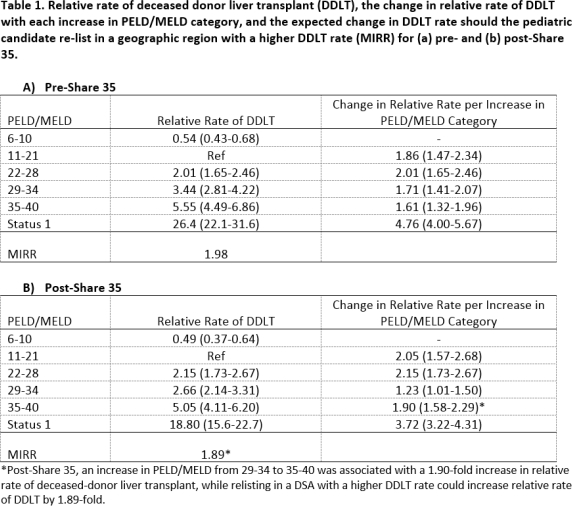Geographic Disparity in Access to Deceased-Donor Liver Transplantation for Pediatric Candidates
1JHU, Baltimore
2US Naval Academy, Annapolis.
Meeting: 2018 American Transplant Congress
Abstract number: 361
Keywords: Liver transplantation, Pediatric
Session Information
Session Name: Concurrent Session: Liver: Pediatrics
Session Type: Concurrent Session
Date: Monday, June 4, 2018
Session Time: 4:30pm-6:00pm
 Presentation Time: 5:06pm-5:18pm
Presentation Time: 5:06pm-5:18pm
Location: Room 608/609
Geographic disparity in access to deceased-donor liver transplantation (DDLT) is largely uncharacterized for pediatric candidates. We investigated geographic disparity in DDLT rates across Donation Service Areas (DSAs) for pediatric liver candidates using a robust metric of disparity before and after Share35.
METHODS: Using SRTR data 6/2010-6/2016, we identified 4,690 pediatric (<18yrs) liver transplant candidates and estimated PELD/MELD-adjusted DDLT rates using multilevel Poisson regression. PELD/MELD was categorized empirically. From the regression model, we derived the incidence rate ratio (IRR) of DDLT rates between each pair of DSAs and the median of the IRRs (MIRR). MIRR is derived from the variation in DDLT rates across DSAs and represents an overall measure of geographic disparity. Larger MIRR indicates greater disparity.
RESULTS: In the three years pre- and post-Share35, MIRR was 1.98 and 1.89, respectively. In other words, two pediatric candidates with the same PELD/MELD in different DSAs were expected to have a 1.98-fold difference in DDLT rate pre-Share35 (MIRR = 1.98), and two candidates with the same PELD/MELD in different DSAs were expected to have a 1.89-fold difference in DDLT rate post-Share35 (MIRR =1.89). Comparing MIRR to the impact of PELD/MELD on DDLT rates, after Share35 an increase in PELD/MELD from 29-34 to 35-40 was associated with 1.90-fold higher rate of DDLT (Table 1B, Col. 2) and an increase from 35-40 to Status 1 was associated with a 3.7-fold higher rate, while relisting in a different DSA could increase a pediatric candidates' rate of DDLT by 1.89-fold.
CONCLUSION: Geographic location is a major determinant of access to DDLT for pediatric candidates, and there was minimal change in this disparity following Share35. 
CITATION INFORMATION: Bowring M., Mogul D., Segev D., Gentry S. Geographic Disparity in Access to Deceased-Donor Liver Transplantation for Pediatric Candidates Am J Transplant. 2017;17 (suppl 3).
To cite this abstract in AMA style:
Bowring M, Mogul D, Segev D, Gentry S. Geographic Disparity in Access to Deceased-Donor Liver Transplantation for Pediatric Candidates [abstract]. https://atcmeetingabstracts.com/abstract/geographic-disparity-in-access-to-deceased-donor-liver-transplantation-for-pediatric-candidates/. Accessed December 9, 2025.« Back to 2018 American Transplant Congress
